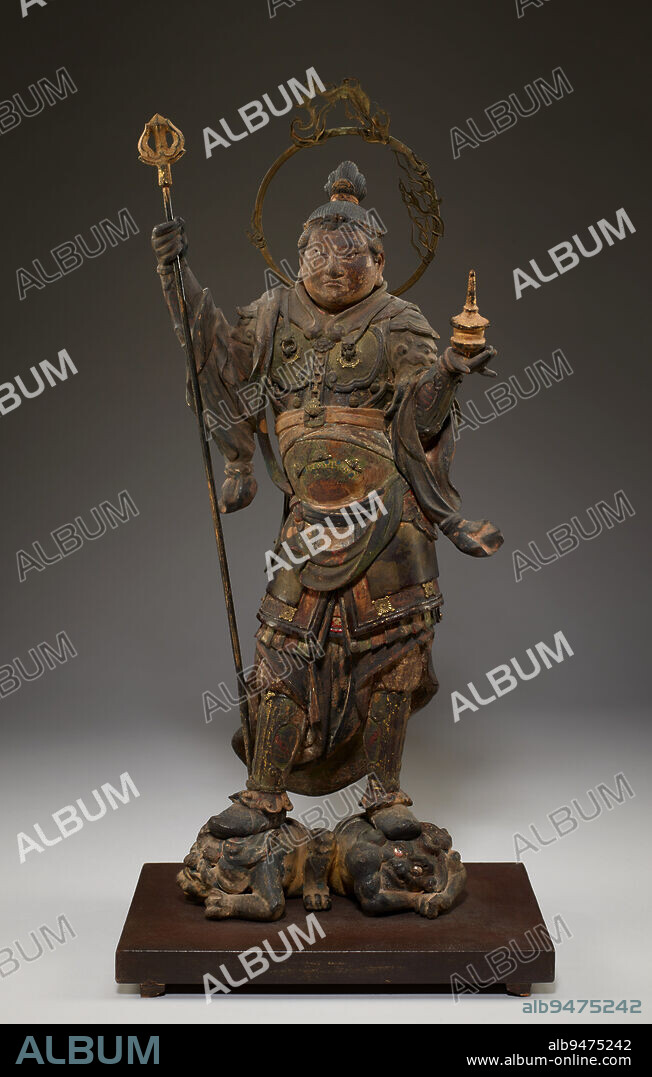alb9475242
Bishamonten, the Guardian of the North, late 13th century, Circle of Higo Busshi Jkei, Japanese, 1184 - after 1256, 18 13/16 × 9 × 6 9/16 in. (47.78 × 22.86 × 16.67 cm), Japanese cypress wood with polychrome, cut gold-leaf, and inlaid crystal; metal, Japan, 13th century, In Hindu mythology, each of the four directions is protected by a specific god. These four gods were incorporated into Buddhism as guardian kings at an early period and came to be known in Sanskrit as Lokapalas, or Shitenn in Japanese. This sculpture of a warrior represents Bishamonten, the Guardian of the North. The north was believed to be the most dangerous of the cardinal directions and so its protector, Bishamonten, is the strongest of the four guardian kings. Here, wearing heavy armor and carrying a lance and miniature stupa, Bishamonten stands atop two demons, representing threats from the North that he has overpowered.

|
Ajouter à une autre Lightbox |
|
Ajouter à une autre Lightbox |



Avez-vous déjà un compte? S'identifier
Vous n'avez pas de compte ? S'inscrire
Acheter cette image

Légende:
Voir la traduction automatique
Bishamonten, the Guardian of the North, late 13th century, Circle of Higo Busshi Jkei, Japanese, 1184 - after 1256, 18 13/16 × 9 × 6 9/16 in. (47.78 × 22.86 × 16.67 cm), Japanese cypress wood with polychrome, cut gold-leaf, and inlaid crystal; metal, Japan, 13th century, In Hindu mythology, each of the four directions is protected by a specific god. These four gods were incorporated into Buddhism as guardian kings at an early period and came to be known in Sanskrit as Lokapalas, or Shitenn in Japanese. This sculpture of a warrior represents Bishamonten, the Guardian of the North. The north was believed to be the most dangerous of the cardinal directions and so its protector, Bishamonten, is the strongest of the four guardian kings. Here, wearing heavy armor and carrying a lance and miniature stupa, Bishamonten stands atop two demons, representing threats from the North that he has overpowered.
Crédit:
Album / quintlox
Autorisations:
Modèle: Non - Propriété: Non
Questions sur les droits?
Questions sur les droits?
Taille de l'image:
4668 x 7336 px | 98.0 MB
Taille d'impression:
39.5 x 62.1 cm | 15.6 x 24.5 in (300 dpi)
Mots clés:
13E SIECLE • 13EME S • ACTION PORTER • BOUDDHISME • BOUDDHISTE • BOUDDIQUE • CERCLE • DANGEREUX • JAPONAIS • JAPONAISE • METAL • METAUX • NORD • PORTER • RELIGION: BOUDDHISME • SCULPTURE • SCULPTURES • TECHNIQUE: SCULPTURE • TREIZIÈME SIÈCLE • XIIIE SIECLE
 Pinterest
Pinterest Twitter
Twitter Facebook
Facebook Copier le lien
Copier le lien Email
Email
